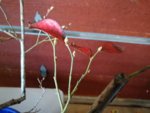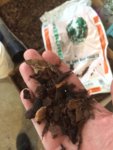Oh well, you repotted your blueberry before I could ''lay down my blueberry sermon''.
I see in your photo that most of the twigs have a terminal flower bud. Excellent, don't prune until after it flowers & fruits if having a few handfuls of home grown blueberries appeals to you. You are growing right so far. It is happy enough to bloom.
I own a small blueberry farm. We only have 3 acres in production, produced a about 3000 pounds hand picked for the farmers markets. And another 7000 pounds went to a university research project. The university pays better than the farmers market. I have enough to plant another acre in pots right now, blueberry cultivars from meristematic tissue culture. Cheapest way to buy newer cultivars.
So here is the scoop on blueberries. They like acidic soils, or in other words, they are calcifuges. They hate excess calcium. This is because they come from environments that are always deficient in calcium. In their native ranges they never encounter an excess of calcium. As a result they have active transport or scavenging of Calcium from their environment. And because they never encounter an excess in their native haunts, they have no OFF SWITCH for calcium uptake. Expose them to too much calcium and they will poison themselves. Most trees just turn off active uptake when there is excess calcium. Blueberries are like carnivorous plants, no off switch for active uptake of calcium. A little too much will eventually kill them. Acidic soils tend to be low in calcium. Ideal soil pH is between 5.0 to 6.0, they will tolerate soils roughly pH 4.0 to somewhere around 6.3 maybe 6.5 But ideal is close to 5.0 to 5.5. Good news is most of the garden center blueberries are newer hybrids, and they have been bred to be a bit more tolerant of warmer winters and less acidic soils. In Tennessee you most likely have a ''Rabbit Eye'' hybrid blueberry, or a southern highbush blueberry. Both often have genetics from both the northern Highbush and one of the Huckleberry species. In other words they are not as touchy as they used to be.
For small plantlets I am sizing up, right up to a full fruiting size bush I use 45 % pine bark, or douglas fir bark or even bark from hardwoods if it has been composted. The next 40 to 45 % is Canadian peat moss. Yes, that fine powdery stuff. The last 10 to 15% is hardwood sawdust. Yes, wood sawdust. The sawdust is to feed the endomycorrhizae that are associated with blueberries. I also add roughly 1 tablespoon elemental sulfur per gallon volume of potting mix, more on this in the water discussion, I am even trying this potting mix in bonsai pots too. With this mix, you need to keep it moist. Do not let it get too dry between watering. If it gets dry, it shrinks and compacts, and then you loose the air penetration. Because it is so fine, it is easy to loose the air penetration. You must repot at least once every other year, because the mix will get too compacted.
In bonsai pots I have also tried 25% bark, 25 % peat moss, 5% sawdust, and 45% pumice or perlite, which ever I had on hand. This mix is good for about 2 years. It is okay to repot every year. Do not let a peat based mix go for 3 or more years, it will break down and change. Roots may go south on you.
Know the water you are irrigating your blueberry with. Rain water is best. If you can, collect and save rain water to water your blueberries and azalea with. If you use municipal or well water, it is good to know your total alkalinity. THe units of alkalinity are expressed as milligrams of Calcium per liter of water, or parts per million of Calcium. Total dissolved solids can be used as an approximation. Don't worry about pH of the water, that number is meaningless. It is total alkalinity that the farmers use to know how to handle their blueberries. pH is trivial, it tells you nothing about how much calcium is present. My irrigation water has a total dissolved solids of about 225 ppm, and an alkalinity of 180 mg Calcium per liter of water. The elemental sulfur I added to the potting mix is the right amount to counteract the calcium that will accumulate from using my 180 mg/liter Calcium municipal water. THe sulfur will dissolve over the course of a year, it is slow to dissolve. As it does it will react with the calcium that has been accumulating in the peat-bark mix. It will keep your potting mix acidic. If your well water has double or triple the amount of calcium as my municipal water you need to increase the amount of elemental sulfur you add.
Any full line garden center, where they cater to organic gardeners and serious vegetable gardeners will have elemental sulfur. Usually in 2 pound bags or 50 pound bags. The grade intended for acidifying your soils will be a fine grit. There is a grade intended as a dormant spray or as a fungicide, this is a much finer grind. Either will work. The finer grind will dissolve faster, add a third less and re-apply 3 times a year. The soil acidifier grind of sulfur you only need to apply once a year.
Fertilizer - Blueberries prefer to take up nitrogen as Ammonia, they do not take up nitrate nitrogen very efficiently at all. The blueberry fertilizer I use on the farm all the nitrogen is ammoniacal nitrogen. Any garden center ''acid plant food'' will have at least some ammonia, and some sulfur in the formulation. Only use acid plant food fertilizers. One or two of the Dyna Grow products and One of the Peters products actually contains calcium and magnesium. A ''Cal-Mag Fertilizer" that supplements both calcium and magnesium will simply kill a number of blueberry cultivars. I know, I killed a couple hundred this way. The northern highbush cultivar 'Duke' is very sensitive to added calcium, where 'Sweetheart', 'Huron', and 'Bluecrop' only showed yellowing in their leaves with the same dose of fertilizer that killed all my 'Duke' blueberries. So as I said earlier, some more modern blueberry hybrids are much more calcium tolerant than the pure species, V. corymbosum and V angustifolium, the wild northern highbush and northern lowbush blueberries.
If anyone is serious about blueberries, I can repackage down a fertilizer designed specifically for blueberries, it will be about $15 in one pound containers, or $65 in 25 pound bags. PM me. This fertilizer would be good for azaleas and gardenia too.
Pruning a blueberry. - there are some tricks. Once you start developing a fine branch structure, watch out for coarse ''sucker'' growth in closer to the trunk. What will happen is the unbranched sucker will monopolize plant resources, and the more ramified part will starve and die off. Prune out sucker growth. The root system of a blueberry will live 100 years or more. Each branch, coming up from the roots will normally live about 20 years, then the roots will withdraw resources from that trunk in favor of younger, less ramified trunks. If you keep your blueberry a single trunk, that trunk can last 25 to 40 years, but you have to stay on top of less ramified sucker type growth to prevent the roots from withdrawing support. Or grow your blueberry as a clump, keep the number of trunks limited, but have a succession of trunks developing. You can easily keep a single trunk 20 or more years. In commercial production for fruit, trunks that are between 4 years and 10 years produce the maximum yield, and then yield, total weight of the fruit, drops off as the trunk ages over 10 years. Commercial fruit bushes are pruned so no wood on the bush is older than 10 to 15 years. Trunks will just stop flowering and begin to die off after they are somewhere in the 20 to 30 year old range in a large multi-trunk highbush blueberry.









